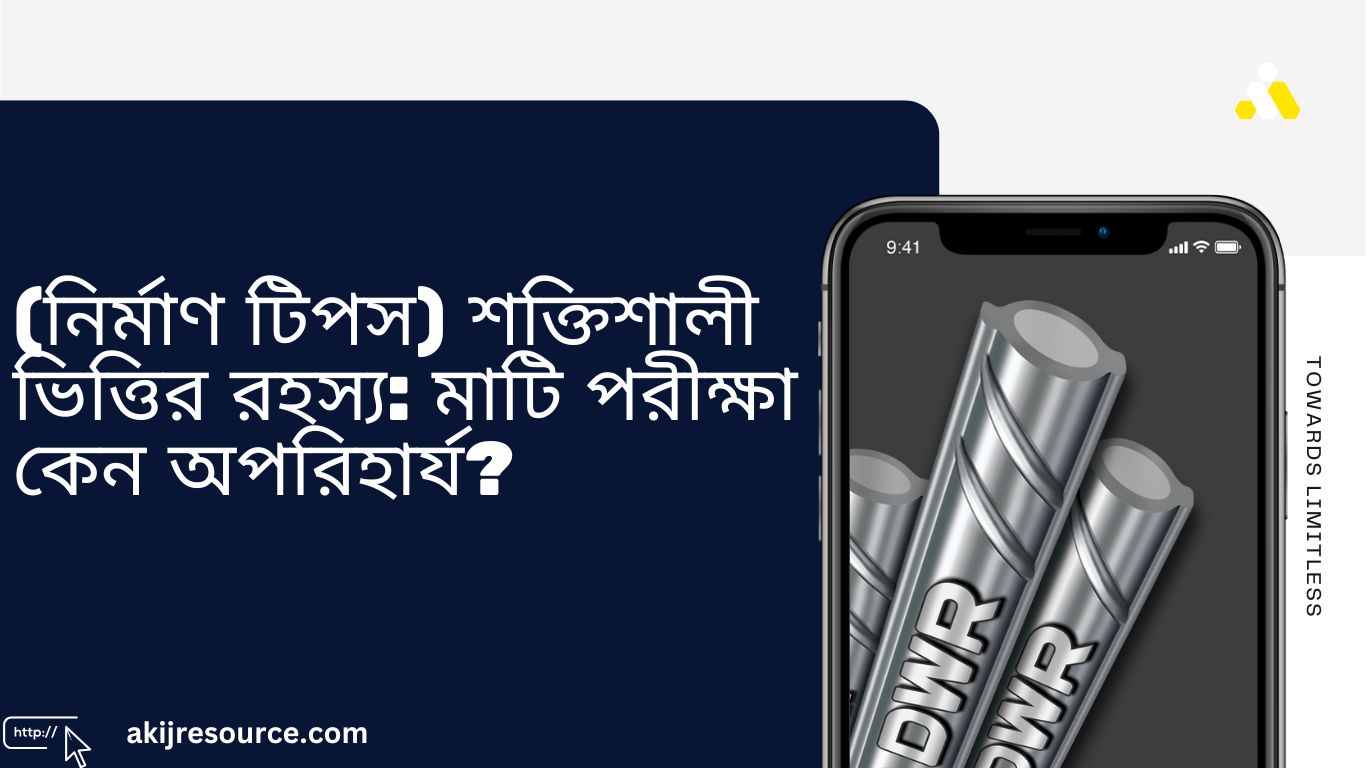Deformed with Ribs (DWR) rebar offers superior bonding with concrete and enhances structural integrity. It is ideal for construction in Bangladesh.
Remember those black-and-white photos of construction sites, with workers hauling heavy steel beams and pouring concrete by hand? Well, hold onto your hard hats, because the future of construction is here, and it’s anything but old-school. TMT rebar, the backbone of modern structures, is evolving at lightning speed, thanks to cutting-edge technologies that are transforming the industry.
Short answer: The future of TMT rebar is all about innovation – think drones, 3D printing, and AI-powered design.
Keep reading to discover:
- The game-changing tech trends that are revolutionizing construction in Bangladesh
- How these innovations can boost your project’s efficiency, safety, and sustainability
- Real-world examples of how tech is already making a difference
- How Akij Ispat is leading the charge in providing cutting-edge TMT rebar solutions
Let’s leave the past behind and step into the future of construction, where possibilities are limitless.
Understanding DWR Rebar
The construction industry in Bangladesh has seen significant advancements with the introduction of Deformed With Ribs (DWR) rebar. This innovative material offers numerous benefits that enhance buildings’ structural integrity and durability. Understanding DWR rebar is essential for construction professionals aiming to improve the quality and longevity of their projects. This deep dive will explore the advantages of DWR rebar, focusing on its definition, manufacturing process, and importance in construction.
What Is DWR Rebar?
DWR rebar stands for Deformed With Ribs rebar. DWR rebar is a type of steel reinforcement bar used in concrete structures. Its unique feature is its surface, which is deformed with ribs. These ribs provide better mechanical anchoring in the concrete, enhancing the bond between the steel and the concrete.
Here are some key characteristics of DWR rebar:
High tensile strength: DWR rebar has greater tensile strength than smooth bars, making it ideal for heavy-duty constructions.
Enhanced bonding: The ribs on the surface of the rebar improve its grip on the concrete, reducing the chances of slippage.
Corrosion resistance: Many DWR rebars are coated to resist corrosion, which is crucial in humid environments like Bangladesh.
Due to these characteristics, DWR rebar is widely used in various construction projects, including bridges, high-rise buildings, and residential homes.
How DWR Rebar Is Made
The manufacturing process of DWR rebar involves several steps to ensure its quality and performance. Here’s a brief overview of how DWR rebar is made:
Raw Material Selection: High-quality steel is selected as the raw material to ensure the final product’s strength and durability.
Heating: The steel billets are heated to a high temperature in a furnace to make them malleable.
Rolling: The heated billets are passed through rolling mills, where they are shaped into the desired diameter and length.
Ribbing: The rolled steel bars are then passed through ribbing machines, which create the characteristic surface deformations.
Cooling: The deformed bars are cooled and controlled to achieve the required mechanical properties.
Quality Control: The finished rebar undergoes rigorous testing to meet
industry standards for tensile strength, flexibility, and bonding capacity.
This meticulous process ensures that DWR rebar provides construction projects the necessary strength and durability.
Importance In Construction
DWR rebar plays a crucial role in the construction industry, particularly in developing countries like Bangladesh. Here are some reasons why DWR rebar is essential:
Structural Integrity: DWR rebar enhances the structural integrity of buildings and bridges, making them more resistant to seismic activities and heavy loads.
Longevity: The improved bond between the rebar and concrete reduces the likelihood of cracks and other structural issues, extending the lifespan of the construction.
Cost-Effective: Although DWR rebar may be slightly more expensive than smooth bars, its durability and reduced maintenance costs make it a cost-effective choice in the long run.
Safety: Enhanced structural integrity translates to safer buildings, protecting the lives of occupants and reducing the risk of catastrophic failures.
In summary, DWR rebar is an invaluable material in the industry, and its use in construction projects ensures stronger, more durable, and safer structures.
The Advantages Of DWR Rebar
Bangladesh is rapidly developing its infrastructure, and construction quality is crucial. One vital component in modern construction is Deformed With Ribs (DWR) rebar. This blog post will explore the various advantages of DWR rebar in construction projects in Bangladesh.
Enhanced Load-bearing
DWR rebar provides exceptional load-bearing capacity, essential for high-rise buildings and bridges. Its unique ribbed design distributes loads more evenly across the structure, resulting in increased stability and durability.
Here are some key benefits:
Increased Structural Integrity: The ribs allow for better load distribution.
Enhanced Durability: Withstands higher loads without deforming.
Safety: Reduces the risk of structural failure.
Consider a comparison:
|
Type |
Load-Bearing Capacity |
|---|---|
|
Plain Rebar |
Lower |
|
DWR Rebar |
Higher |
Resistance To Shear Forces
DWR rebar excels in resisting shear forces, which can compromise structural integrity. Shear forces act parallel to the cross-section of materials, causing sliding or tearing. The ribbed design of DWR rebar helps absorb and distribute these forces more effectively.
Advantages include:
Enhanced Stability: Better resistance to shear forces.
Longer Lifespan: Reduces the risk of shear-related failures.
Improved Safety: Minimizes structural damage.
Shear force resistance is crucial in:
Earthquake-prone areas
Heavy traffic zones
Industrial buildings
Superior Bond Strength
One of the main advantages of DWR rebar is its superior bond strength with concrete. The ribbed surface creates a mechanical bond, which is stronger than the bond achieved with plain rebar.
Benefits include:
Improved Structural Cohesion: Stronger bond between rebar and concrete.
Reduced Slippage: The ribs prevent movement within the concrete.
Enhanced Load Transfer: Better load transfer between concrete and rebar.
Applications where bond strength is critical:
High-rise buildings
Bridge construction
Reinforced concrete structures
Cost-effectiveness
DWR rebar is effective and cost-efficient. While the initial cost may be higher than plain rebar, the long-term benefits outweigh the initial expense.
Key points include:
Long-Term Savings: Reduced maintenance and repair costs.
Increased Durability: Longer lifespan of structures.
Fewer Materials Needed: Enhanced strength allows for fewer rebar pieces.
Consider the cost-effectiveness:
|
Aspect |
Plain Rebar |
DWR Rebar |
|---|---|---|
|
Initial Cost |
Lower |
Higher |
|
Maintenance |
Higher |
Lower |
|
Lifespan |
Shorter |
Longer |
Cost Efficiency
The construction industry in Bangladesh is evolving rapidly. One key advancement is using the Deformed With Ribs (DWR) rebar. This material offers numerous benefits, especially in terms of cost efficiency. Understanding the advantages of DWR rebar can help builders and developers make more informed choices.
Reduced Material Usage
DWR rebar is designed to provide better grip and bonding with concrete. This feature leads to reduced material usage in construction projects. Here are some key points:
Higher Strength: DWR rebar has a higher tensile strength than traditional rebar. Therefore, builders can use less rebar without compromising structural integrity.
Improved Bonding: The ribs on the rebar enhance its grip with concrete. This results in a stronger and more durable structure, reducing the need for additional materials.
Optimized Design: Engineers can design structures using optimized materials, leading to significant cost savings and more efficient projects.
Consider the following table comparing traditional rebar and DWR rebar:
|
Feature |
Traditional Rebar |
DWR Rebar |
|---|---|---|
|
Tensile Strength |
Low |
High |
|
Material Usage |
High |
Low |
|
Bonding with Concrete |
Weak |
Strong |
Lower Maintenance Costs
DWR rebar reduces material usage and leads to lower maintenance costs. Here’s why:
Enhanced Durability: The strong bonding between DWR rebar and concrete enhances the structure’s overall durability. This means fewer repairs and lower maintenance expenses over time.
Corrosion Resistance: DWR rebar often comes with better corrosion resistance. This is crucial in Bangladesh’s humid climate, as it ensures the structure’s longevity.
Less Frequent Inspections: Structures built with DWR rebar require fewer inspections and maintenance checks. This saves time and money for builders and property owners.
Here’s a quick comparison on maintenance costs:
|
Aspect |
Traditional Rebar |
DWR Rebar |
|---|---|---|
|
Durability |
Low |
High |
|
Corrosion Resistance |
Poor |
Excellent |
|
Maintenance Frequency |
High |
Low |
By choosing DWR rebar, builders in Bangladesh can ensure their projects are both cost-efficient and long-lasting and robust.
Durability Factors
Deformed With Ribs (DWR) rebar is popular in Bangladesh’s construction industry due to its remarkable durability factors. This blog post dives deep into the advantages of DWR rebar, focusing on its durability aspects such as corrosion resistance and longevity in harsh conditions. Understanding these factors will help you make informed decisions for your construction projects.
Corrosion Resistance
DWR rebar stands out for its exceptional corrosion resistance. This characteristic is crucial in Bangladesh, where humidity levels are often high. Corrosion resistance ensures that the rebar maintains its structural integrity over time, reducing maintenance costs and enhancing the lifespan of the construction.
Here are some key points on how DWR rebar achieves this:
Material Composition: DWR rebar is made from high-quality steel, which includes alloying elements like chromium and nickel that enhance its corrosion resistance.
Protective Coating: Many DWR rebars come with a protective coating that acts as a barrier against moisture and other corrosive elements.
Ribbed Surface: The ribbed design not only provides better bonding with concrete but also minimizes the surface area exposed to corrosive agents.
Below is a comparison table illustrating the corrosion resistance of DWR rebar vs. traditional rebar:
|
Feature |
DWR Rebar |
Traditional Rebar |
|---|---|---|
|
Material Composition |
High-Quality Steel with Chromium and Nickel |
Standard Steel |
|
Protective Coating |
Yes |
No |
|
Ribbed Surface |
Yes |
No |
Longevity In Harsh Conditions
DWR rebar is designed to withstand harsh environmental conditions, making it ideal for construction in Bangladesh. Whether it’s coastal areas with salty air or regions with high humidity, DWR rebar proves to be resilient.
Factors contributing to its longevity include:
High Tensile Strength: DWR rebar offers superior tensile strength, which ensures that it can bear heavy loads without deforming.
Thermal Stability: The rebar maintains its properties even under extreme temperature variations, reducing the risk of structural failure.
Resistance to Chemical Attack: It withstands exposure to various chemicals, ensuring its longevity in industrial or polluted environments.
Let’s look at some scenarios where DWR rebar excels:
Coastal Construction: The salt in the air can corrode traditional rebar, but DWR rebar’s protective coating and material composition make it more resistant.
Industrial Areas: Factories and chemical plants release pollutants that can degrade building materials. DWR rebar’s resistance to chemical attack ensures longevity.
High-Humidity Regions: In areas with high moisture content, DWR rebar resists rust and maintains its structural integrity.
By choosing DWR rebar, you ensure that your structures remain robust and durable, even in the harshest conditions.
Dwr Rebar In Bangladesh
The Advantages of Deformed With Ribs (Dwr) Rebar: A Deep Dive (Bangladesh) reveal the growing importance of this construction material. DWR Rebar significantly strengthens concrete structures. In Bangladesh, the adoption of DWR Rebar is on the rise. This post explores why it’s gaining popularity and how it’s manufactured locally.
Market Demand
Bangladesh’s construction sector is booming. With rapid urbanization and infrastructure projects, the demand for high-quality rebar is increasing. DWR Rebar stands out due to its enhanced bonding properties with concrete.
Key factors driving the demand:
Government initiatives for infrastructure development.
Growing real estate market.
Increased awareness of construction safety.
Builders and developers prefer DWR Rebar for its superior performance. It is especially useful for:
High-rise buildings
Bridges
Flyovers
In a recent survey:
|
Construction Type |
Demand for DWR Rebar (%) |
|---|---|
|
Residential |
45% |
|
Commercial |
30% |
|
Infrastructure |
25% |
The market demand for DWR Rebar is expected to grow as Bangladesh continues to develop.
Local Manufacturing Processes
Bangladesh has several local manufacturers producing high-quality DWR Rebar. These manufacturers follow stringent processes to ensure the rebar meets international standards.
Key steps in the local manufacturing process:
Raw Material Selection: High-grade steel is chosen for durability.
Heating: Steel is heated to a high temperature for malleability.
Rolling: The heated steel is rolled into the desired rebar shapes.
Rib Formation: Ribs are formed on the surface to enhance bonding.
Cooling: The rebar is cooled to retain its strength.
Quality Testing: The final product undergoes rigorous testing.
Local manufacturers are investing in advanced technology. This ensures consistent quality and meets the growing demand for DWR Rebar in Bangladesh.
Moreover, local production reduces dependency on imports. This makes DWR Rebar more accessible and affordable for the domestic market.
Environmental Impact
The Advantages of Deformed With Ribs (DWR) Rebar: A Deep Dive (Bangladesh) reveal numerous benefits. One significant aspect is the environmental impact of DWR rebar. Understanding how DWR rebar affects the environment can help industries make better choices. Let’s explore the sustainable practices and recyclability of DWR rebar.
Sustainable Practices
DWR rebar supports sustainable construction practices in many ways. It enhances the durability of structures, reducing the need for frequent repairs and replacements. This longevity means fewer resources are used over time.
Here are some key sustainable practices associated with DWR rebar:
Energy Efficiency: Manufacturing DWR rebar consumes less energy compared to traditional rebar. This reduction in energy usage leads to lower carbon emissions.
Material Efficiency: DWR rebar’s unique design requires less steel to achieve the same strength as traditional rebar. Using less material conserves natural resources.
Reduced Waste: The precision in DWR rebar production results in less waste, as off-cuts and leftovers are minimized.
Improved Load Distribution: The ribs on DWR rebar improve bonding with concrete, distributing loads more efficiently and reducing material fatigue.
Additionally, DWR rebar’s resistance to corrosion extends the lifespan of structures, meaning fewer renovations and demolitions. This long-term durability is a crucial factor in sustainable construction.
Recyclability Of Dwr Rebar
DWR rebar is highly recyclable, making it an eco-friendly choice. Recycling steel reduces the need for raw materials, conserving natural resources. Recycled steel also requires significantly less energy to process.
Benefits of recycling DWR rebar:
Energy Savings: Recycling steel uses about 74% less energy than producing new steel from raw materials.
Reduced Landfill Waste: Recycling DWR rebar keeps steel out of landfills, reducing environmental pollution.
Economic Advantages: The steel industry in Bangladesh benefits economically from recycling, lowering production costs and promoting sustainable growth.
Recycling DWR rebar also helps in reducing greenhouse gas emissions. The process of recycling steel emits fewer pollutants compared to new steel production. This contributes to a cleaner and healthier environment.
In Bangladesh, the adoption of DWR rebar in construction projects aligns with global sustainability goals. By choosing recyclable materials, the construction industry can significantly reduce its environmental footprint.
Comparative Analysis
The construction industry in Bangladesh is evolving rapidly. Among the innovations, Deformed With Ribs (DWR) rebar stands out due to its performance and reliability. This section delves into a comparative analysis between DWR rebar and traditional rebar, highlighting their unique advantages and performance metrics.
Dwr Vs. Traditional Rebar
DWR rebar and traditional rebar serve similar purposes in construction, but they have distinct differences that make DWR rebar more advantageous. Here’s a breakdown:
Strength and Durability: DWR rebar has higher tensile strength compared to traditional rebar. The ribs provide better bonding with concrete, enhancing overall structural integrity.
Corrosion Resistance: DWR rebar is often treated with anti-corrosion coatings, making it more resistant to environmental factors, unlike traditional rebar which corrodes easily.
Cost-Effectiveness: Although DWR rebar might have a higher upfront cost, its durability and longer lifespan make it cost-effective in the long run.
Ease of Use: DWR rebar’s ribbed surface ensures easier handling and installation, reducing labor time and costs.
Here’s a comparative table to summarize:
|
Feature |
DWR Rebar |
Traditional Rebar |
|---|---|---|
|
Strength |
High |
Moderate |
|
Durability |
High |
Low |
|
Corrosion Resistance |
High |
Low |
|
Cost-Effectiveness |
High |
Moderate |
|
Ease of Use |
High |
Moderate |
Performance Metrics
The performance of construction materials is crucial. DWR rebar excels in several performance metrics compared to traditional rebar. Let’s examine some key aspects:
Tensile Strength: DWR rebar exhibits higher tensile strength, ensuring it can withstand greater force without breaking.
Bonding with Concrete: The ribbed design of DWR rebar improves bonding with concrete, enhancing structures’ overall stability.
Load-Bearing Capacity: DWR rebar has a higher load-bearing capacity due to its enhanced tensile strength and better bonding.
Fatigue Resistance: DWR rebar is more resistant to fatigue, making it suitable for structures subjected to fluctuating loads.
Longevity: The superior corrosion resistance of DWR rebar ensures a longer lifespan, reducing maintenance and repair costs.
These metrics illustrate why DWR rebar is a preferred choice in modern construction projects, particularly in environments like Bangladesh where durability and cost-efficiency are paramount.
Future Trends
The construction industry in Bangladesh is evolving rapidly, and one key element driving this change is the use of Deformed With Ribs (DWR) rebar. This type of rebar offers numerous advantages, especially regarding structural integrity and crack control. As we look to the future, several trends are emerging that promise to enhance further the benefits of DWR rebar in construction projects across the country.
Innovations In Rebar Technology
Recent advancements in rebar technology are transforming the way we approach concrete reinforcement. These innovations are improving the bond strength of deformed rebar and making it more efficient and cost-effective.
Some of the key innovations include:
High-strength rebar: New materials and manufacturing techniques have led to the development of high-strength deformed rebar, which offers better performance and durability.
Corrosion-resistant coatings: Advanced coatings are now being applied to DWR rebar to protect it from rust and corrosion and extend its lifespan.
Smart rebar: Integration of sensors and smart technology in rebar enables real-time monitoring of structural integrity and early detection of potential issues.
These innovations are particularly relevant in Bangladesh, where Akij Ispat is leading the way in adopting and promoting these advanced construction materials. By leveraging these technologies, the construction industry can achieve greater efficiency, safety, and sustainability.
Potential Market Growth
The demand for DWR rebar in Bangladesh is poised for significant growth. Several factors are contributing to this potential market expansion:
Urbanization: Rapid urbanization drives the need for more robust and durable construction materials, including high-quality deformed rebar.
Infrastructure development: Major infrastructure projects, such as bridges, highways, and commercial buildings, require reliable concrete reinforcement solutions.
Government initiatives: Supportive policies and investments in the construction sector encourage using advanced materials like DWR rebar.
According to industry analysts, the market for DWR rebar in Bangladesh is expected to grow steadily over the next decade. This growth is fueled by the increasing recognition of the benefits of deformed rebar in enhancing structural integrity and ensuring long-term durability.
Furthermore, local manufacturers like Akij Ispat are crucial in meeting the rising demand. By producing high-quality DWR rebar domestically, they are not only supporting the construction industry but also contributing to the country’s overall economic growth.
Frequently Asked Questions
What Is Dwr Rebar?
DWR rebar enhances concrete strength, also known as Deformed with Ribs rebar. Its surface ribs improve its bond with concrete, making it ideal for construction.
Why Use Dwr Rebar In Bangladesh?
DWR rebar offers superior durability in Bangladesh’s climate. It resists corrosion and enhances structural integrity, making it suitable for various projects.
How Does Dwr Rebar Improve Construction?
DWR rebar provides excellent grip on concrete, reducing slippage and increasing load-bearing capacity. This ensures robust and durable structures.
What Are The Main Advantages Of Dwr Rebar?
DWR rebar offers enhanced bonding with concrete. It resists corrosion and improves structural integrity. It also withstands high stress and tension.
Conclusion
Choosing Dwr rebar for construction projects in Bangladesh ensures durability, cost-effectiveness, and structural integrity. Its enhanced grip and resistance to environmental factors make it a superior choice. Invest in Dwr rebar to secure long-lasting and resilient structures. Trust in its proven benefits for sustainable construction in Bangladesh.
- বাড়ি তৈরির খরচ বাঁচানোর উপায়: সহজ পদ্ধতি জানুন - February 23, 2025
- AKIJ Ispat Retailers Explore Excellence at World-Class Facility - January 13, 2025
- New Leadership, New Heights: AKIJ Ispat Appoints Mr. Galib Mohammad as CEO - January 13, 2025











